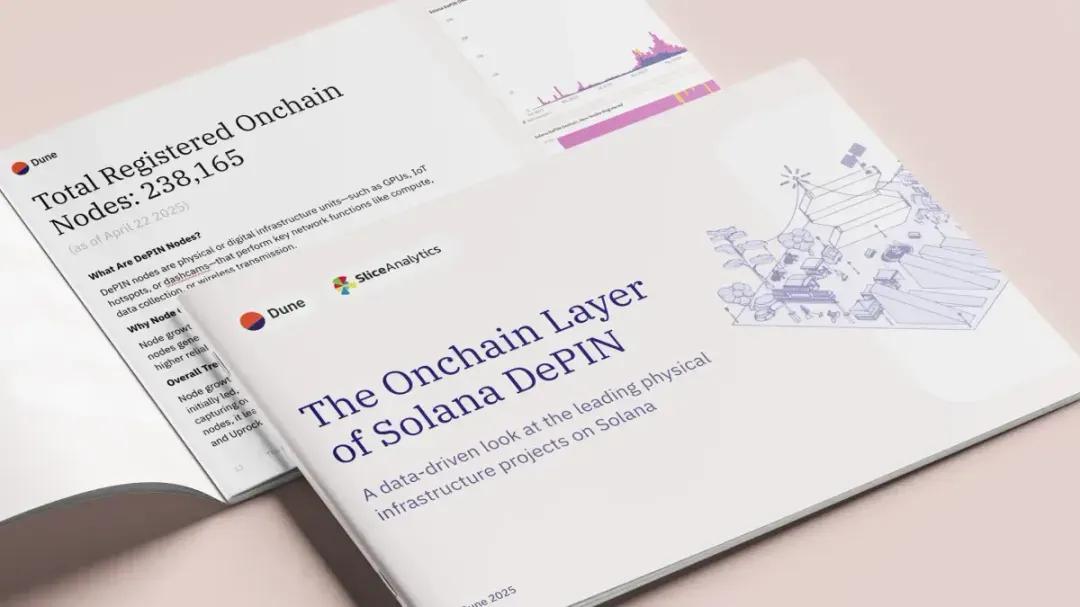
Original text: Dune, Slice Analytics
Compiled by: Yuliya, PANews
Among the many innovations in the blockchain industry, Decentralized Physical Infrastructure Networks (DePIN) are rapidly emerging as a bridge for bringing real-world assets on-chain. Whether it’s shared GPUs, telecom networks, or street map collection, DePIN is reshaping the construction and operation of infrastructure through cryptocurrency incentive mechanisms. Solana is gradually becoming the core platform of this trend, with its high-performance network providing an ideal expansion ground for DePIN projects.
This article is based on the latest research report jointly released by Dune and Slice Analytics, providing an in-depth analysis of the development status, market performance, and on-chain data of several core DePIN projects on Solana. The report data is as of April 22, 2025, offering a clear picture of this emerging ecosystem and revealing its real and verifiable growth trajectory.
DePIN Concept and Solana Advantages
What is DePIN?
Decentralized Physical Infrastructure Networks (DePIN) is an innovative model that utilizes cryptocurrency incentive mechanisms to initiate and operate real-world infrastructure. These projects typically target markets with strong demand but inefficient supply, activating idle resources (such as unused GPUs, wireless bandwidth, etc.). Unlike traditional infrastructure models dominated by large enterprises, DePIN allocates ownership to individuals, thereby improving efficiency, enhancing resilience, and expanding accessibility.
Why Choose Solana?
With its high throughput, low transaction fees, and composable infrastructure, Solana has become the ideal platform for the transparent expansion of DePIN applications. Its thriving ecosystem and strong developer community are making it the center of this emerging field. As Amira Valliani, head of DePIN at the Solana Foundation, stated:
"DePIN is about to reach escape velocity. This innovative business model has proven its ability to scale physical infrastructure networks faster and cheaper in a community-driven manner - all happening on Solana. The world's largest DePIN projects choose to build on Solana because of its high performance and active capital markets, and they are drawn by its thriving community ecosystem."
DePIN Market Overview
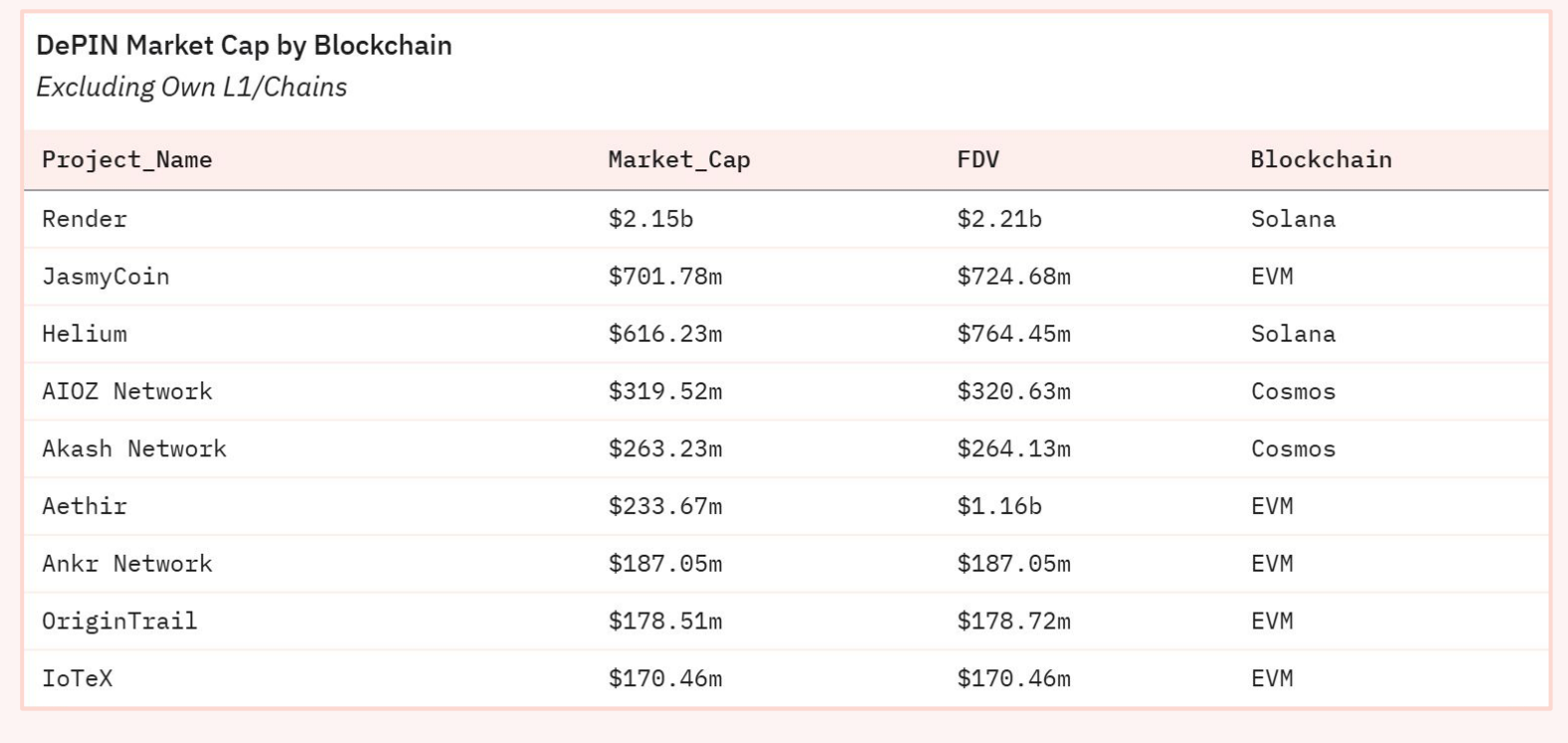
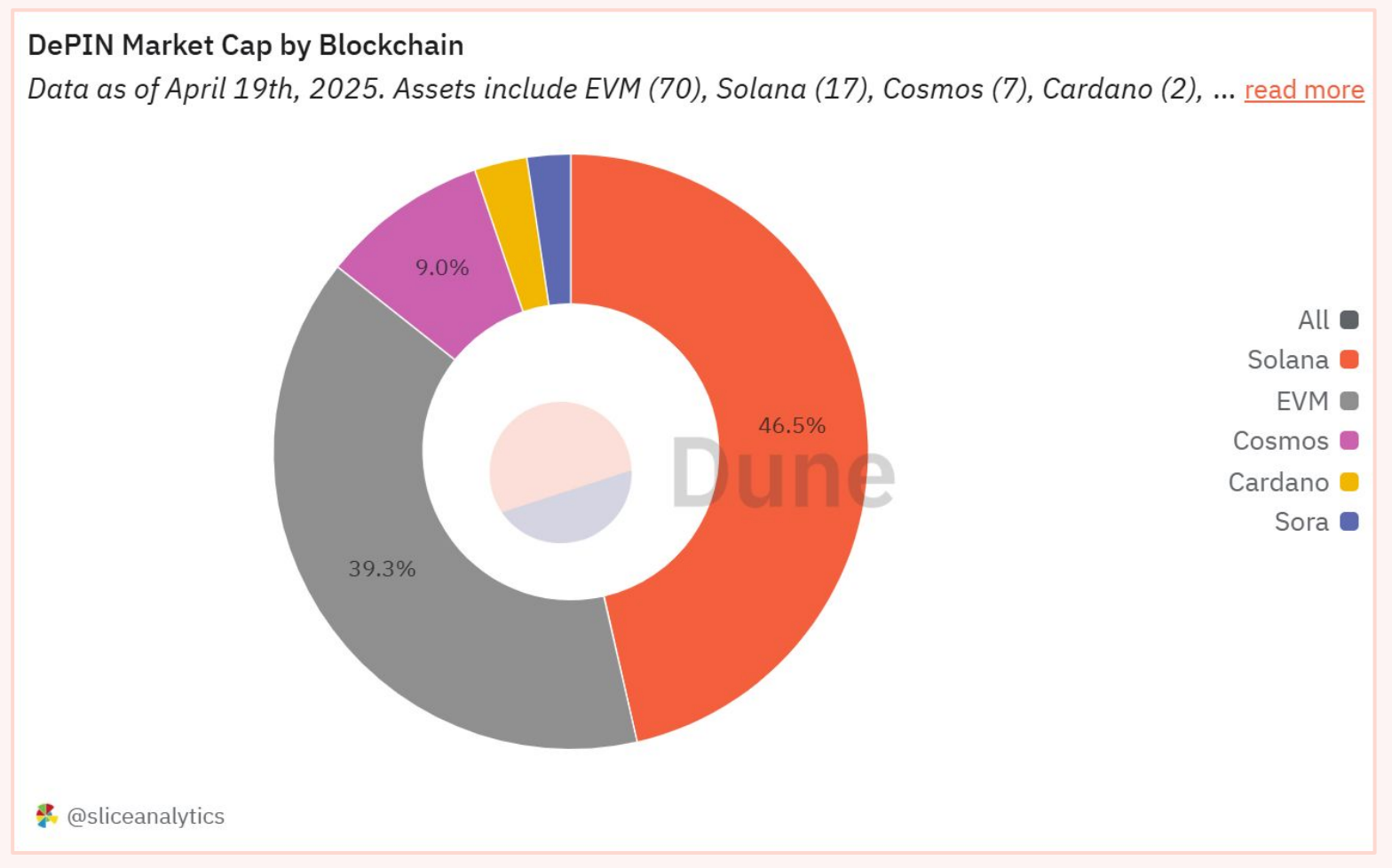
As of April 2025, the total on-chain market capitalization of global DePIN projects (excluding independent projects L1/chains) has reached $7.1 billion, with the total market capitalization of DePIN projects on Solana at $3.25 billion, leading EVM ($2.84 billion) and other blockchain platforms such as Cosmos ($652.5 million), Cardano ($195.2 million), and Sora ($160.1 million).
Calculating the average market capitalization per project, Solana again leads with $191.3 million, followed by Cardano ($97.6 million), Cosmos ($93.2 million), Sora ($80.1 million), and EVM ($40.6 million).
Project Category Distribution

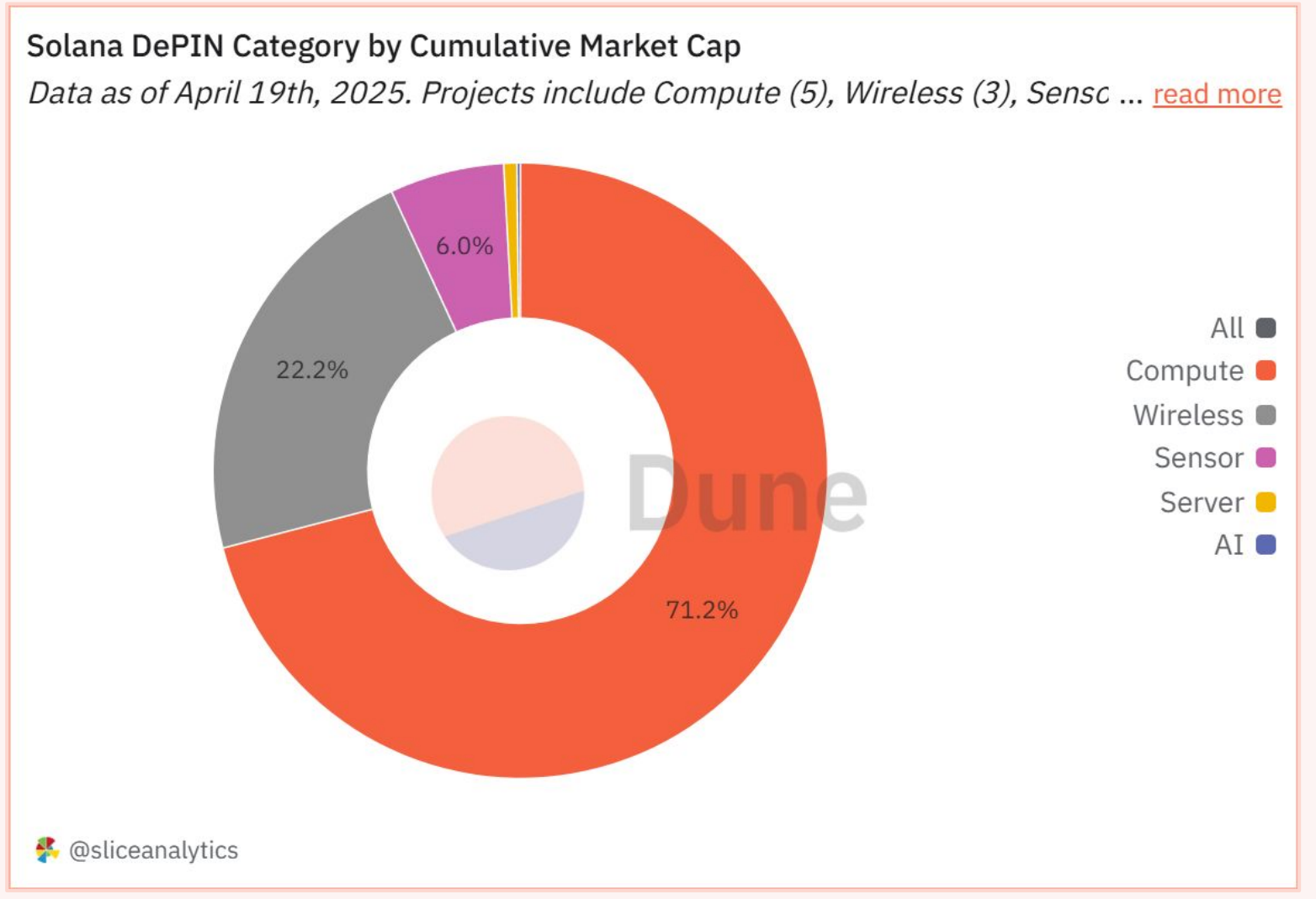
DePIN projects are mainly divided into five categories:
- Compute: Accounting for 71.2% of the market share, providing decentralized processing power, GPUs, and computing infrastructure, such as Render, io.net, Nosana, LooPIN Network, Hivello.
- Wireless: Accounting for 22.2% of the market share, providing community-driven wireless and mobile access networks, such as Helium, ROAM Token, Helium Mobile.
- Sensor: Collecting real-world data through distributed sensing devices, such as Hivemapper, Geodnet, WeatherXM, NATIX Network.
- Server: Providing distributed cloud and storage servers for hosting or accessing data, such as Shadow Token, ScPrime.
- AI: Supporting decentralized networks for AI data generation, labeling, or robotics, such as UpRock, Homebrew Robotics Club.
The compute and wireless categories together account for 93.4% of the market share and also have the highest average market capitalization. Compute networks like Render and io.net provide high market cap utility tokens for AI workloads, while wireless projects like Helium and ROAM represent the most mature and widely adopted infrastructure layers.
Node Growth and Network Participation
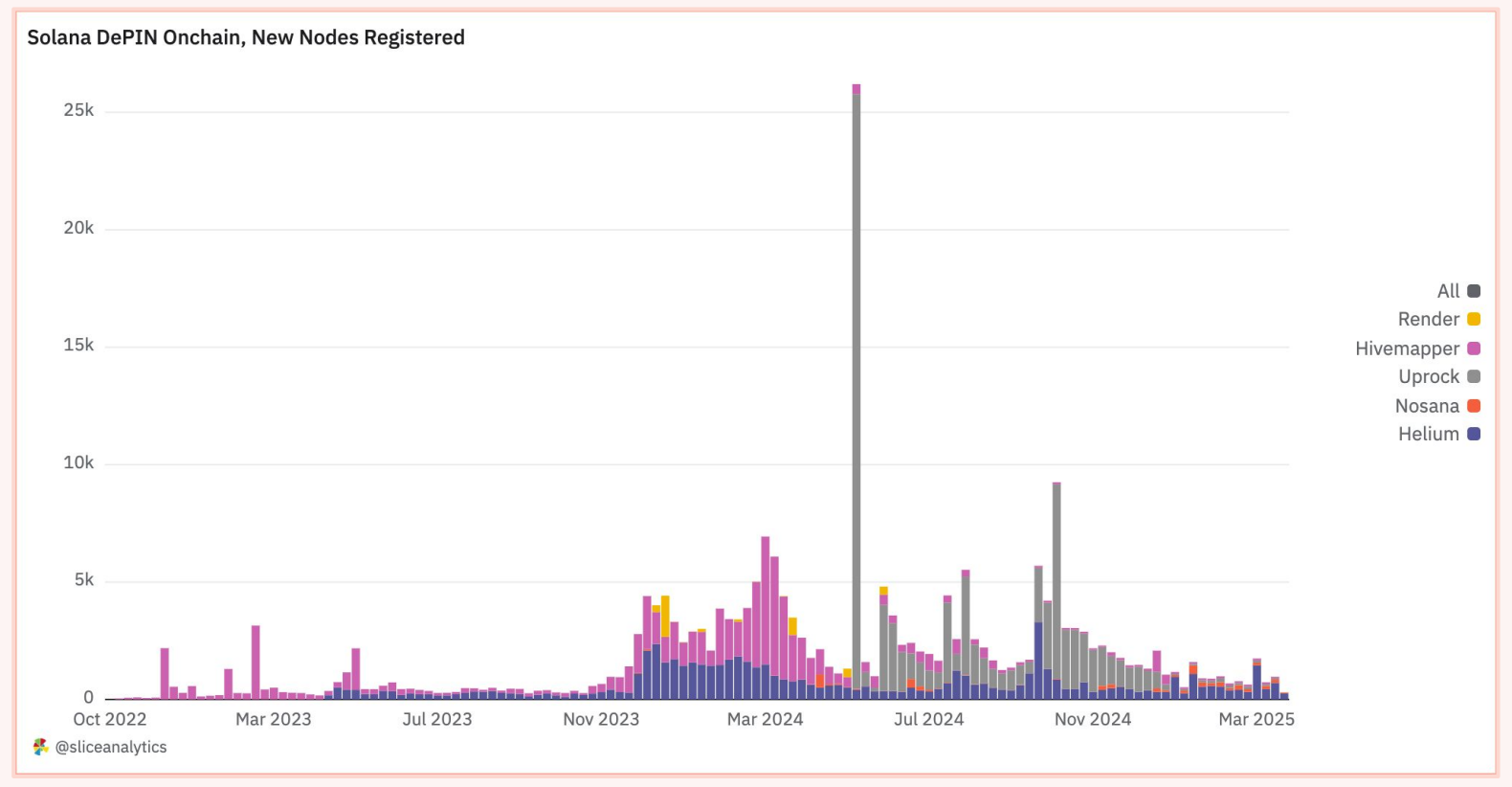
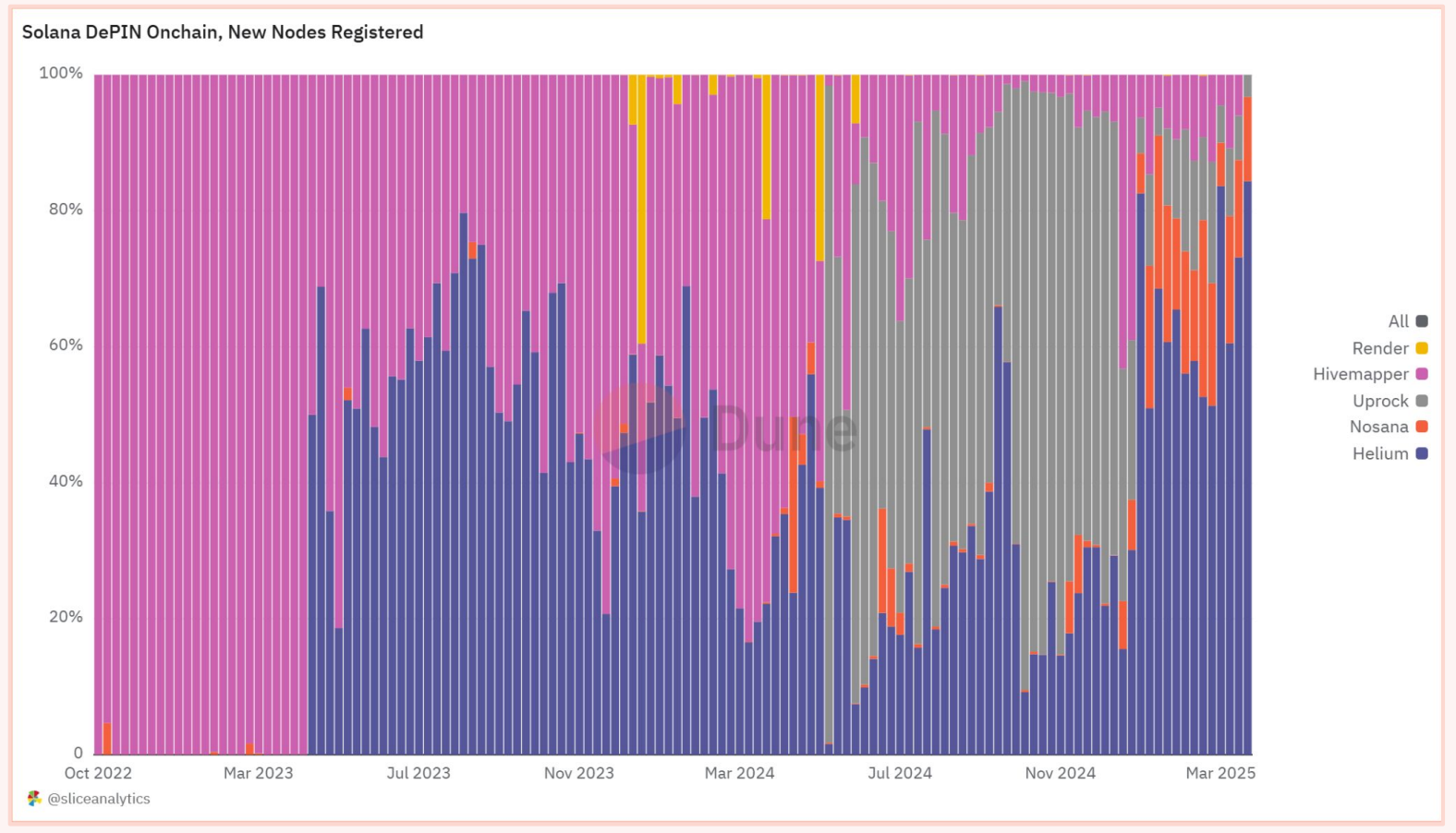
As of April 22, 2025, the total number of registered on-chain nodes for DePIN projects on Solana has reached 238,165. DePIN nodes are units of physical or digital infrastructure, such as GPUs, IoT hotspots, or dashcams, performing key network functions like computation, data collection, or wireless transmission. The growth in the number of nodes reflects the scale, decentralization, and practicality of the network; more nodes typically mean stronger coverage, higher participation, and reliability.
In terms of node growth, Solana's DePIN projects show significant changes. Hivemapper initially led, but Helium quickly surpassed it after launching Helium Mobile, now accounting for over 60% of new node shares. Although Render contributed fewer new nodes, it leads in revenue per node. Nosana gained traction in early 2025, while Uprock stabilized after rapid growth at the end of 2024.
On-Chain Network Revenue
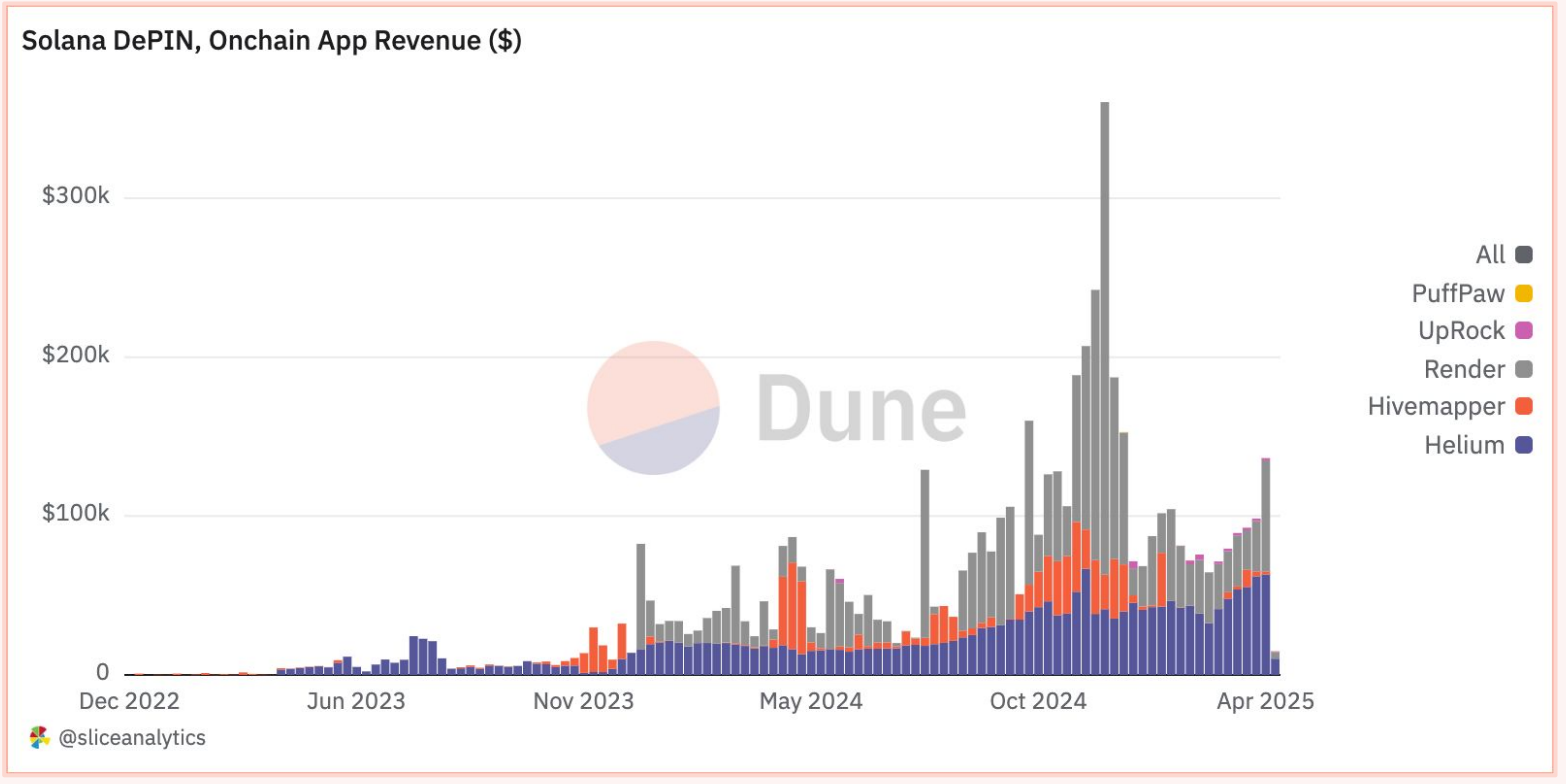
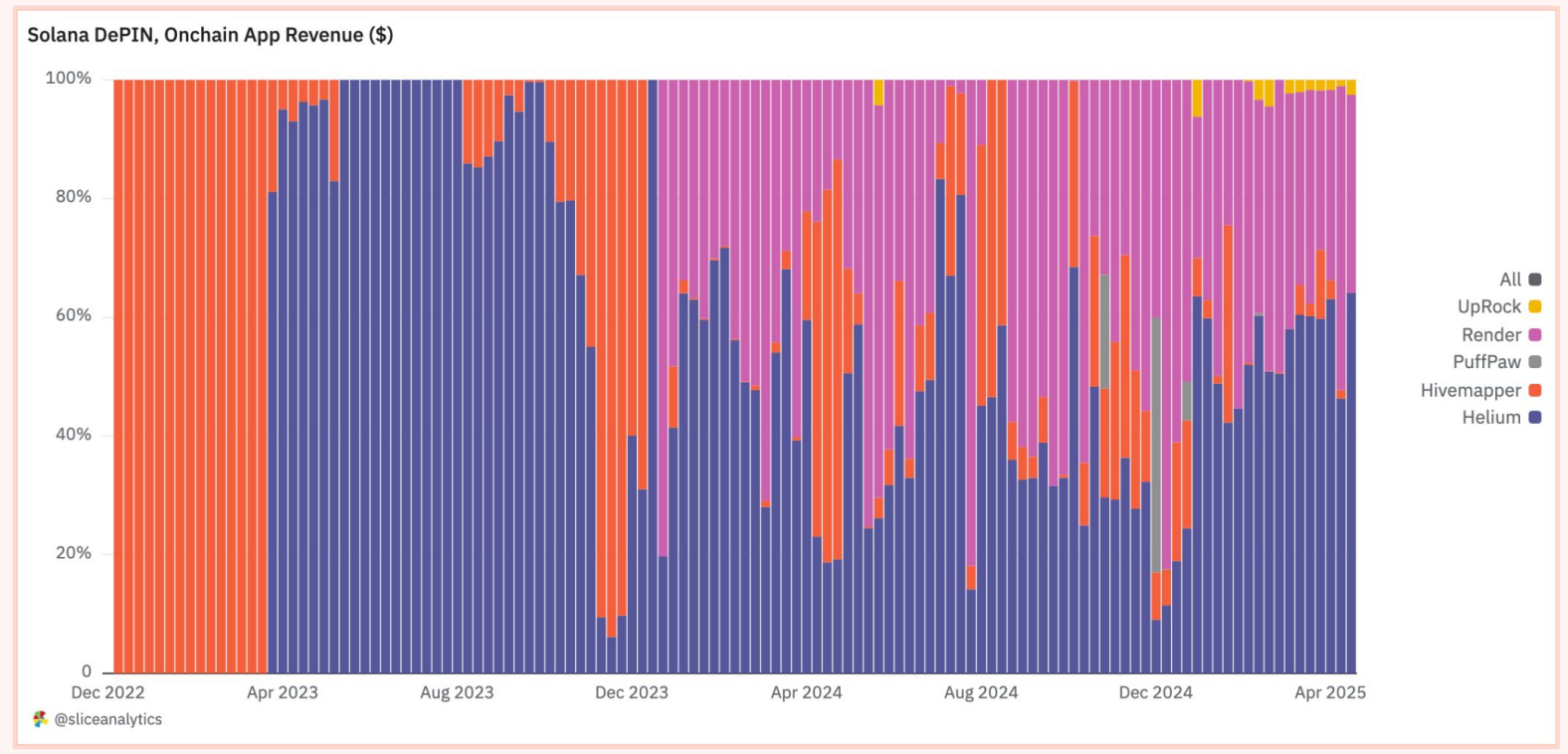
As the cryptocurrency industry matures, on-chain revenue has become a key indicator for assessing project feasibility, product-market fit, and sustainable business models. As of April 22, 2025, the total on-chain revenue of DePIN projects on Solana reached $5.98 million.
The revenue of DePIN projects on Solana has steadily increased, growing from about $4,000 per week in April 2023 to over $100,000 per week in early 2025, peaking at $130,000 in mid-April. Helium is the highest weekly earner, reaching $60,000 (60% share), while Render leads in total revenue ($2.65 million, compared to Helium's $2.3 million). Render also maintains the record for a single-week revenue peak of $300,000 set at the end of 2024. These trends highlight the rising adoption rates, with each project gaining traction at different points in the DePIN growth cycle.
Major Project Analysis
1. Helium: Leader in Decentralized Wireless Networks
Helium is a decentralized wireless network that enables individuals to deploy hotspots and provide low-cost, secure connections for IoT and mobile devices. Users earn HNT tokens by expanding coverage and routing data.
Key Milestones:
- 2013: Helium founded
- 2019: Helium hotspots launched, users begin earning HNT for coverage
- 2023: Migration to Solana to enhance scalability and speed
- 2024: Public launch of Helium Mobile, a decentralized 5G service
- 2025: Launch of Zero Plan, the first free 5G phone plan in the U.S.
- 2025: SEC dismisses lawsuit against Nova Labs, confirming Helium's token model does not violate securities laws
- 2025: Helium partners with AT&T to provide nationwide Wi-Fi coverage
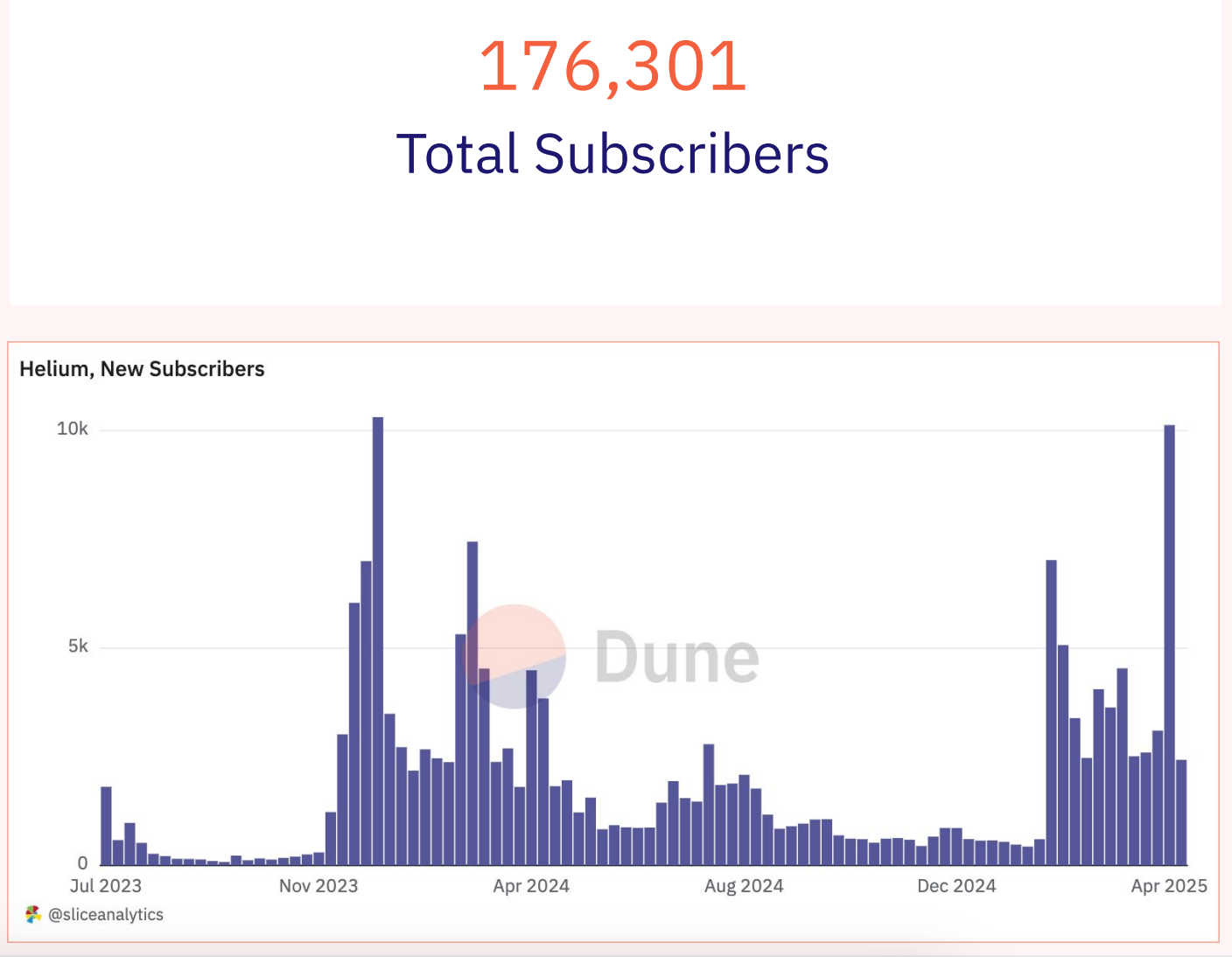
Key Data:
- Total subscribed users: 176,301
- Total number of nodes: 69,449
- Total on-chain revenue: $2.29 million
Helium's subscriber growth has been significantly influenced by clear product-driven inflection points. In the week following the official launch of Helium Mobile in January 2024, new subscribers reached 10,300, facilitating the deployment of more hotspots and network expansion. Subsequently, the launch of the Zero Plan (the first free 5G phone plan in the U.S.) in February 2025 triggered a second wave of growth, quickly filling the waiting list. After the free plan was opened to everyone in April, the number of users peaked again at 10,000.
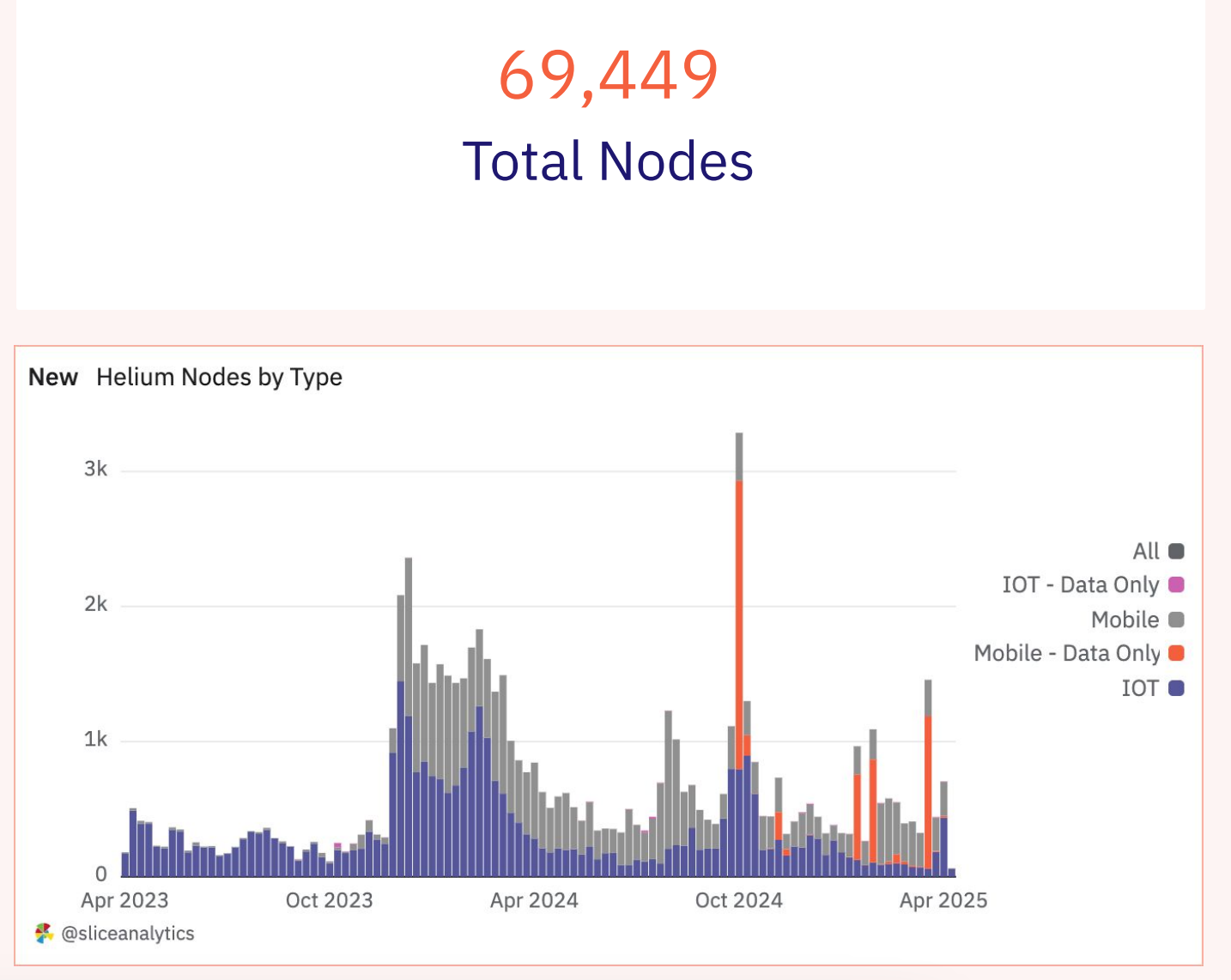
As of the reporting period, Helium's total number of subscribers has reached 176,301, with a total of 69,449 nodes. The composition of nodes shows a continuously changing trend, with particularly strong growth in the mobile data-specific category. The report notes that two major events drove the peak in node deployment. The first was the partnership with Ameriband in October 2024, which added over 100,000 data-only hotspots at retail and commercial sites in the U.S.; the second was the acceleration of user growth after the waiting list for the Zero Plan was lifted in April 2025.
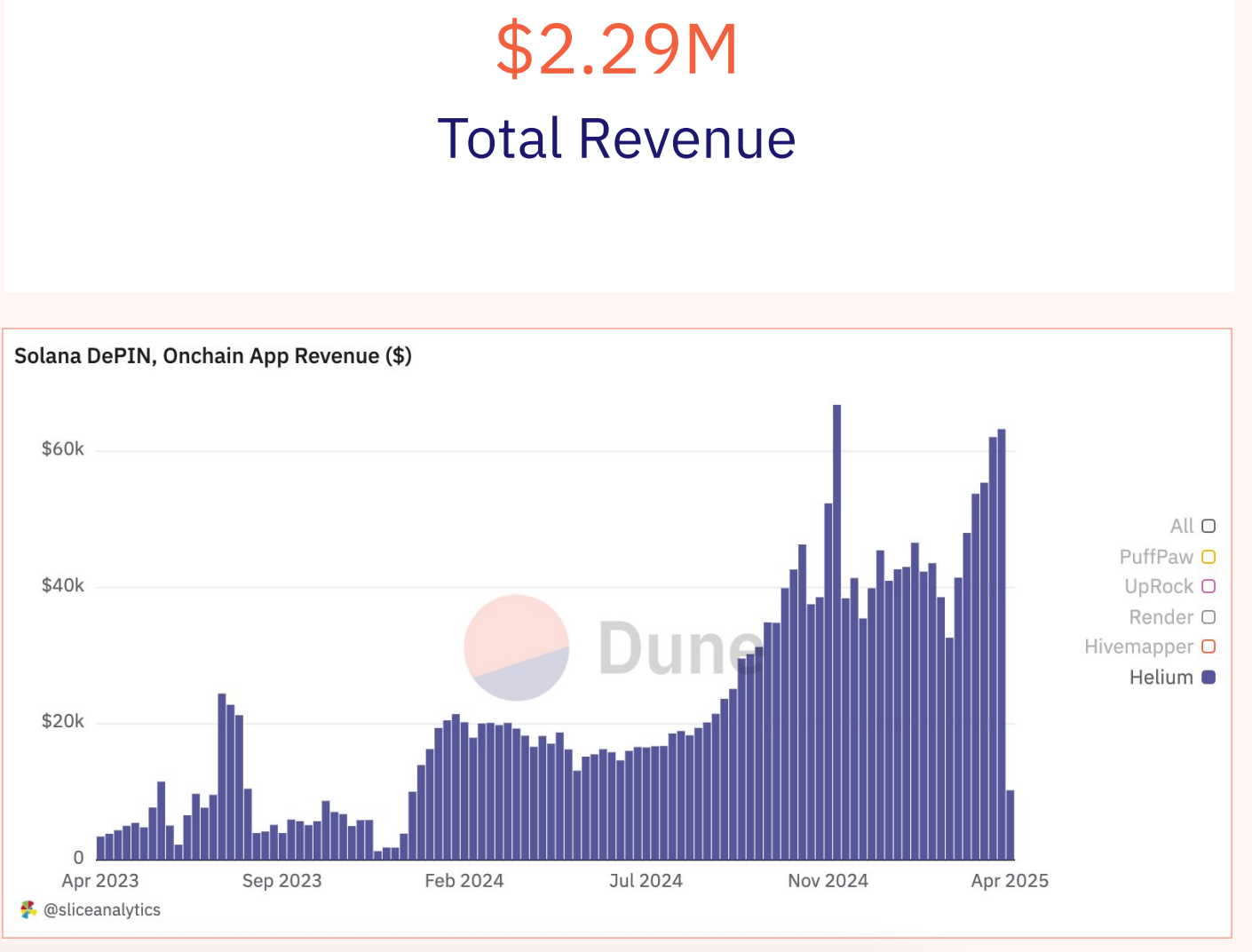
Helium generates on-chain revenue through its unique burn-mint model, allowing users to convert HNT into non-transferable Data Credits (DCs) to access services on its IoT and mobile networks. Specifically, mobile data is charged at $0.50 per gigabyte (i.e., 50,000 DCs), while IoT usage is charged incrementally per 24-byte message. Company revenue has steadily increased, setting a record of $66,000 per week in December 2024, and reaching a sustained peak of $63,000 per week again in April 2025.
2. Hivemapper: Decentralized Mapping Network
Hivemapper is a decentralized, community-driven mapping network where users collect street-level images through dashcams to earn HONEY tokens. By transforming everyday driving into a data source, Hivemapper provides fresher and more dynamic maps for transportation, logistics, and autonomous driving.
Key Milestones:
- 2022: Launch of the Hivemapper network and HONEY token
- 2023: Unique road kilometers mapped by the network exceed 1 million
- 2024: Launch of the Bee dashcam for high-quality image capture
- 2024: Release of Beekeeper, a fleet management tool without SaaS lock-in
- 2025: Bee Maps begins serving major clients like TomTom, Mapbox, and Trimble
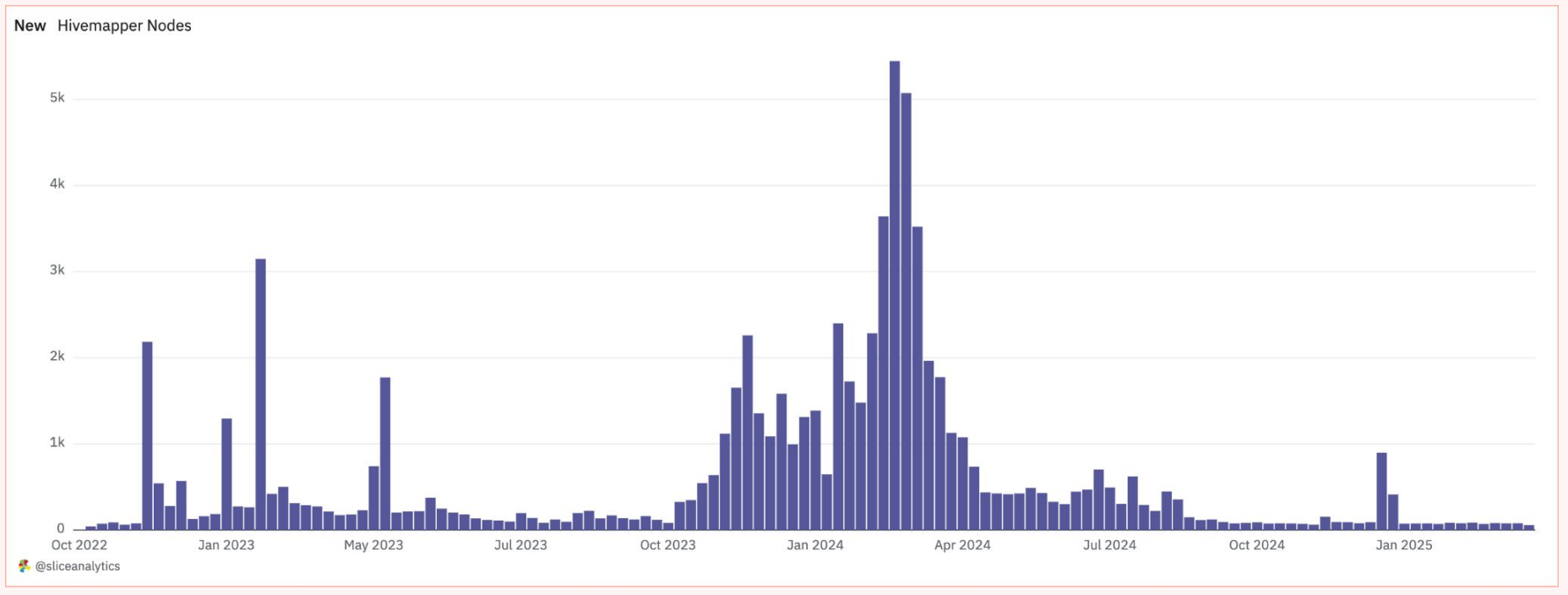
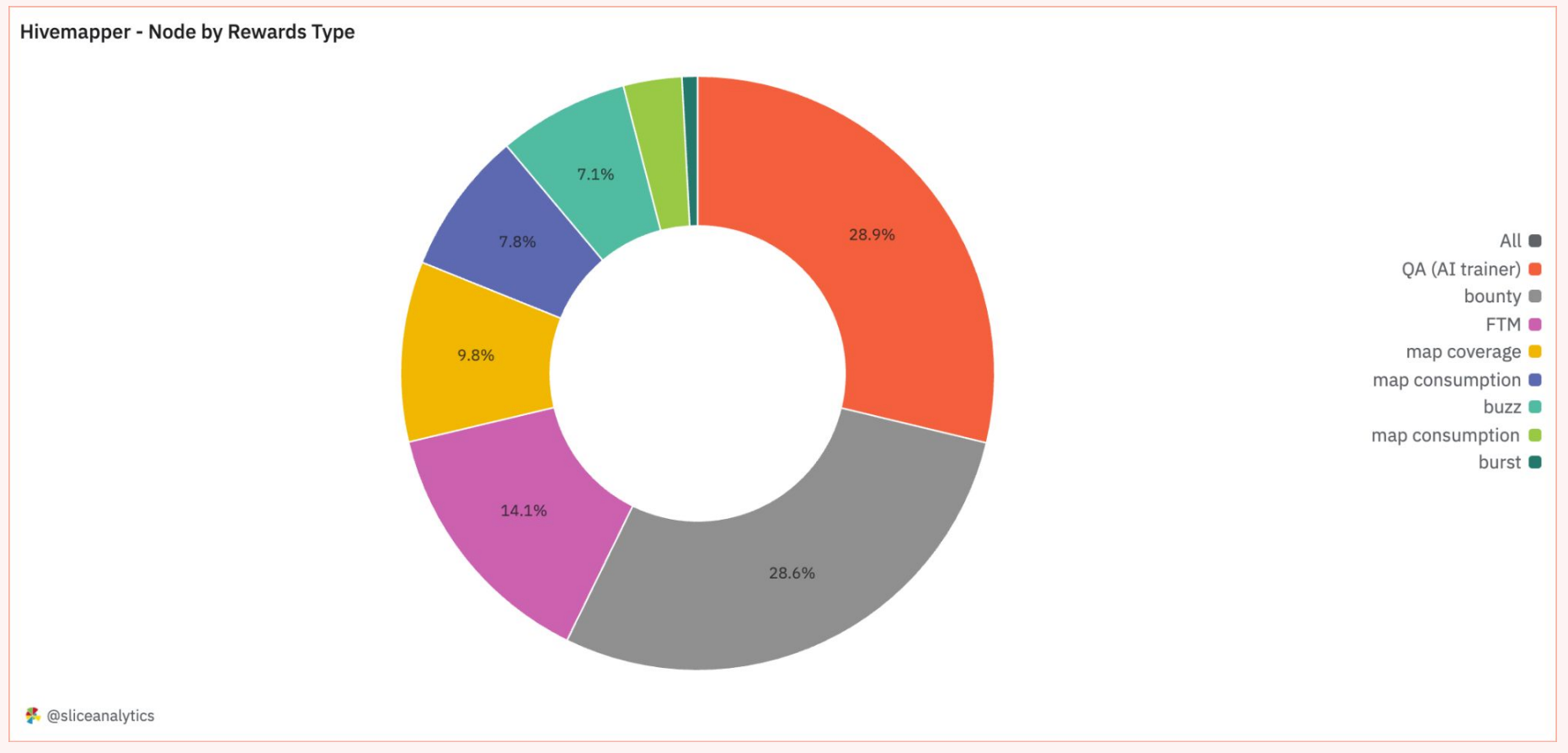
Key Data:
- Total number of nodes: 77,483
- Weekly rewards: Over $60,000 in HONEY
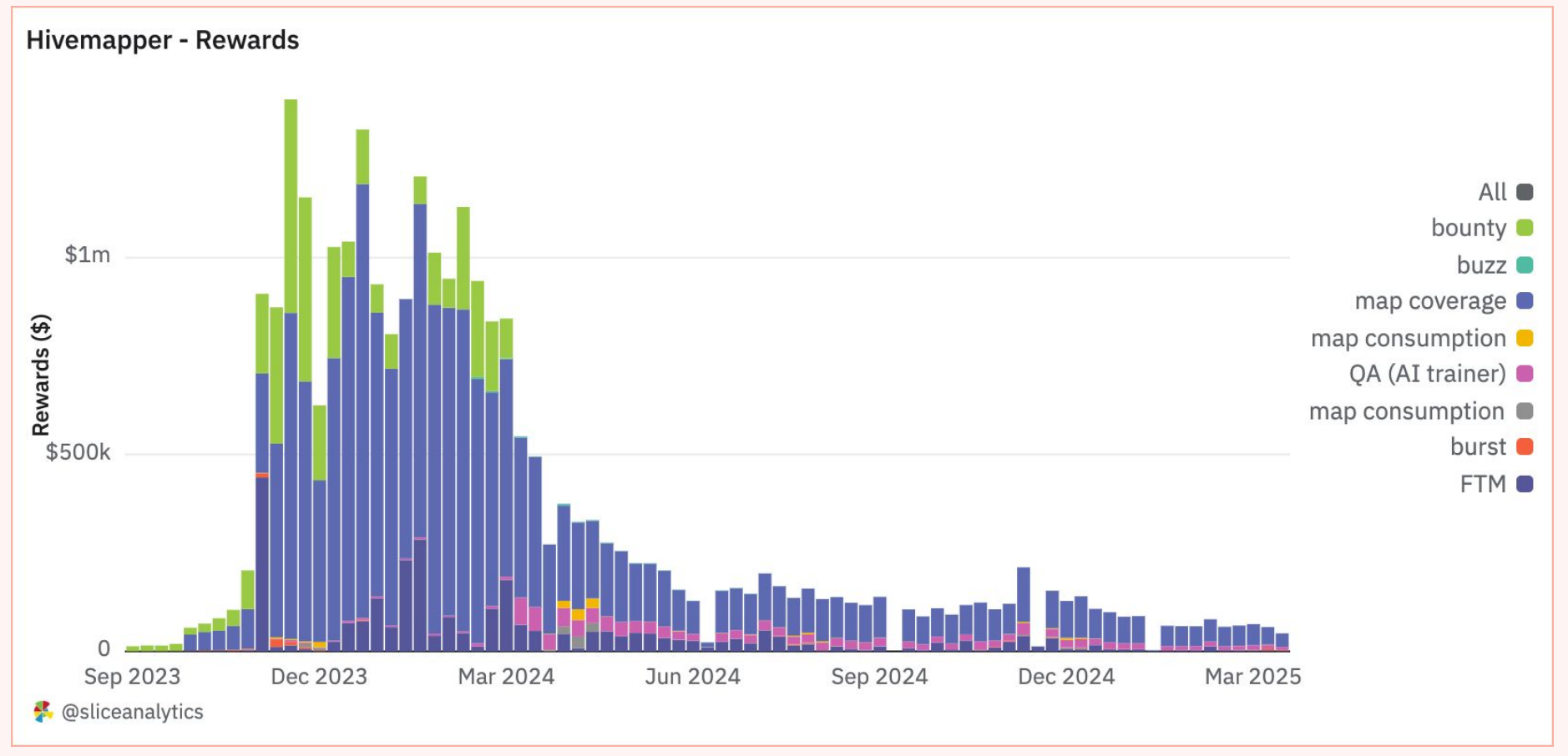
As of April 2025, the network has 77,483 nodes, most of which are active in AI training and bounty activities; however, less than 10% of nodes earn rewards for map coverage. Although Hivemapper's weekly rewards have decreased from a peak of $1.4 million in December 2023, the network still distributes over $60,000 in HONEY tokens weekly. Notably, while less than 10% of nodes actively contribute to map coverage, these nodes consistently receive about 80% of the total rewards.
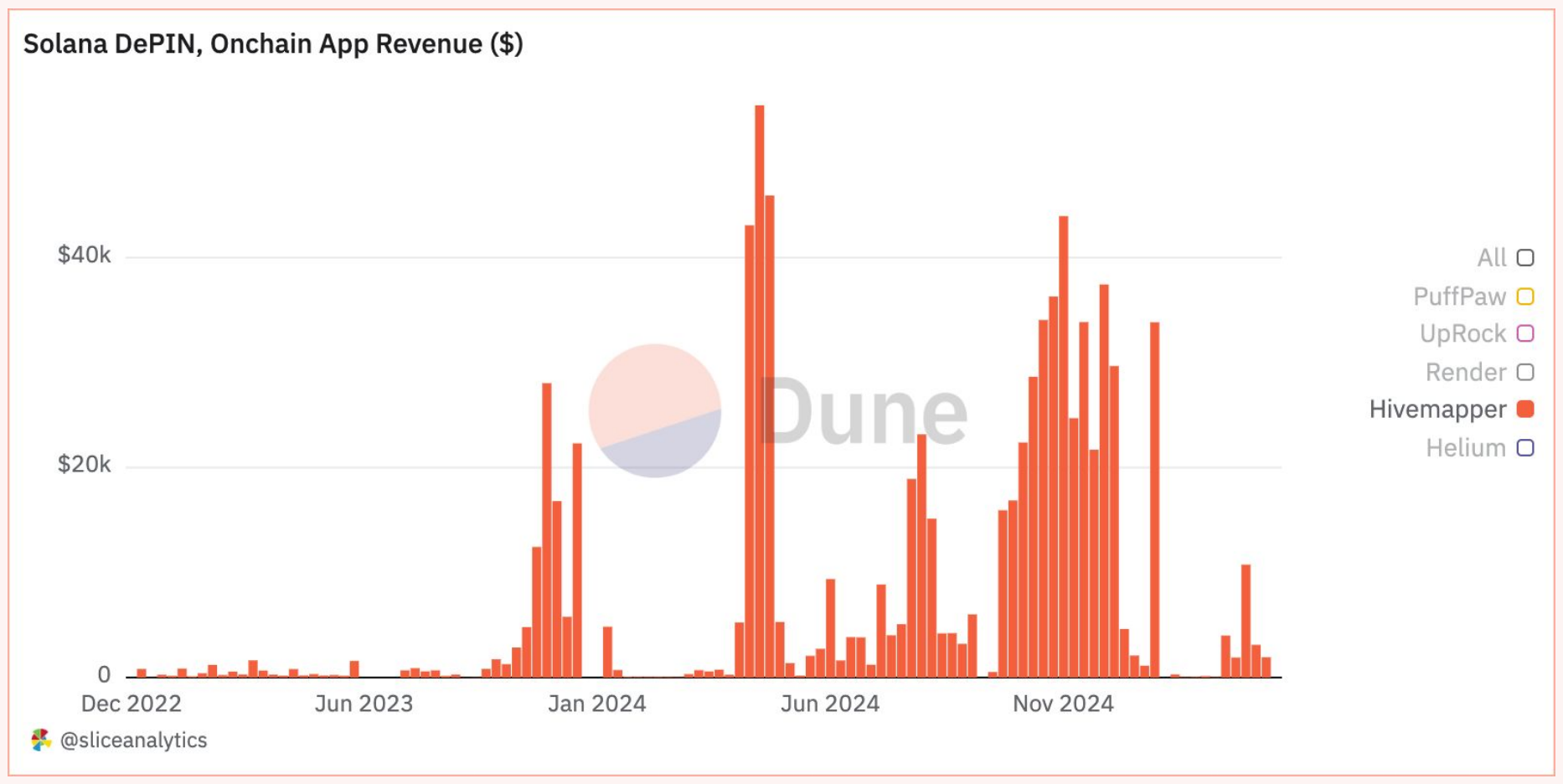
Hivemapper earns revenue by selling Map Credits (valued at $0.005 each), which are purchased by burning HONEY tokens to access map data. Revenue trends show a peak of $30,000 per week at the end of 2023, exceeding $50,000 per week during April to May 2024.
3. Render: Decentralized GPU Rendering Network
Render Network is a high-performance distributed GPU rendering network that facilitates a computational marketplace between GPU providers and requesters using industry-leading OTOY Inc. software. GPU owners can monetize idle GPUs by providing computational power to creators seeking rendering resources. It offers scalable and economical rendering services for 3D graphics, dynamic design, and AI workloads.
Key Milestones:
- 2021: Launch of the Render decentralized rendering network
- 2023: Migration to Solana and upgrade of the token to RENDER
- 2024: Integration of OctaneRender for Blender through RNP-017
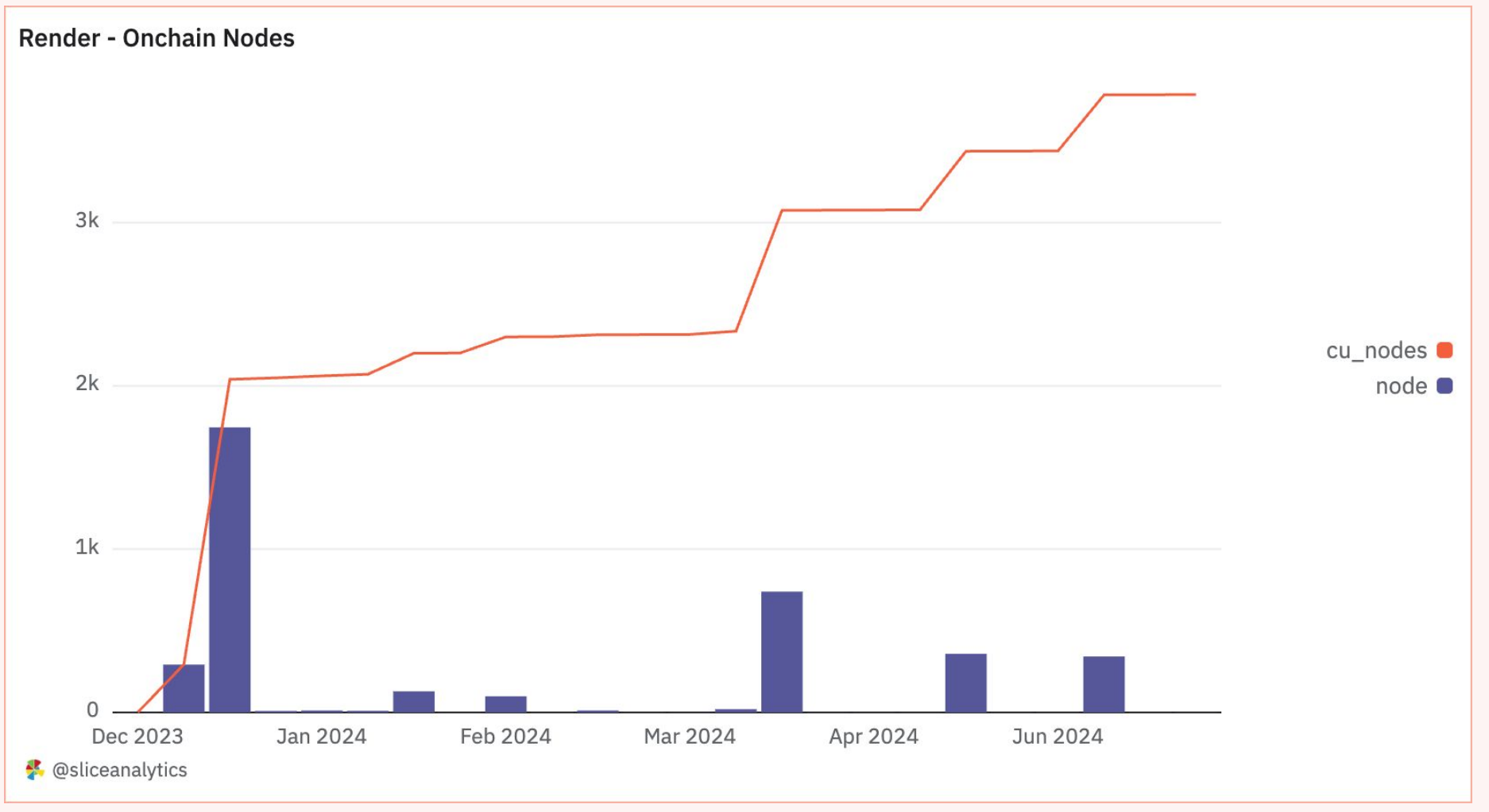
Key Data:
- Active on-chain nodes: 3,784
- RENDER tokens burned: Over 121 million
- Tokens distributed to node operators: Over 2.4 million
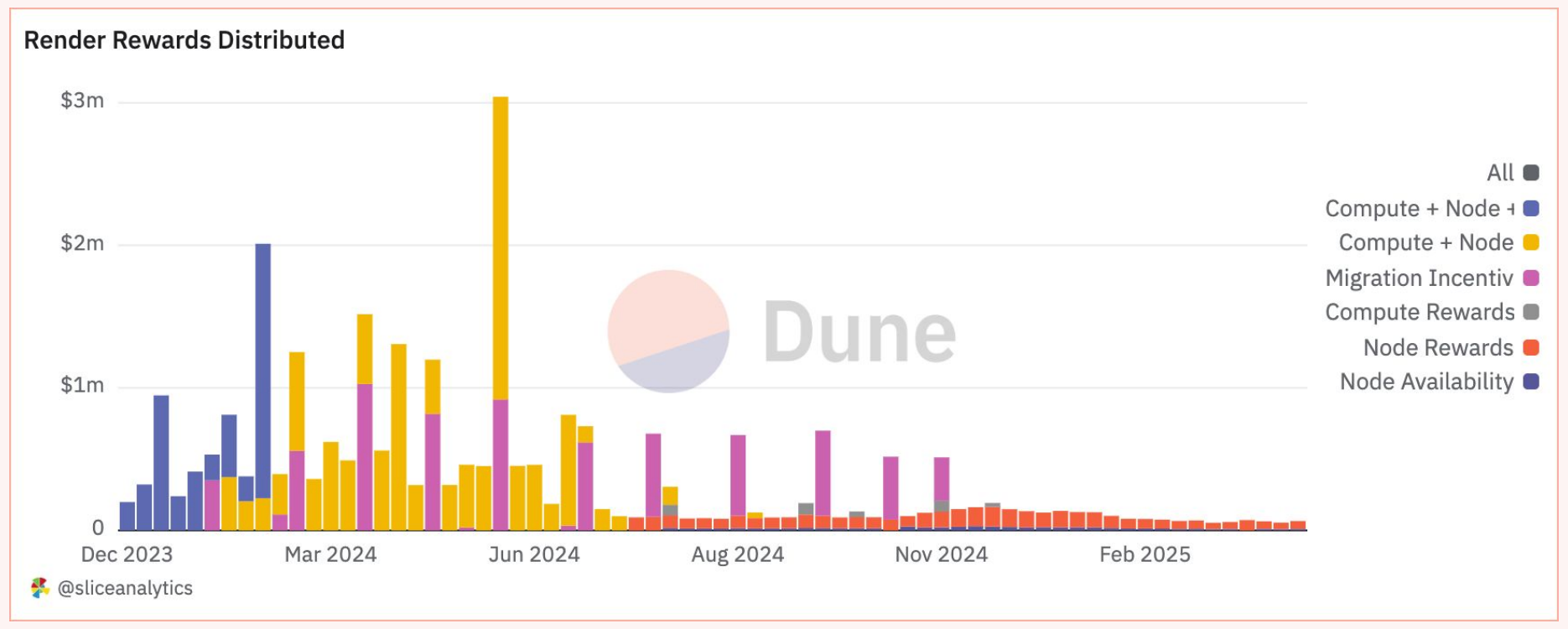
Render Network allows anyone with idle GPU capacity to become a node operator, contributing computational power for decentralized rendering and AI infrastructure. Node operators lease their GPU capacity to artists, studios, and AI developers needing scalable, on-demand computation, in return for RENDER tokens.
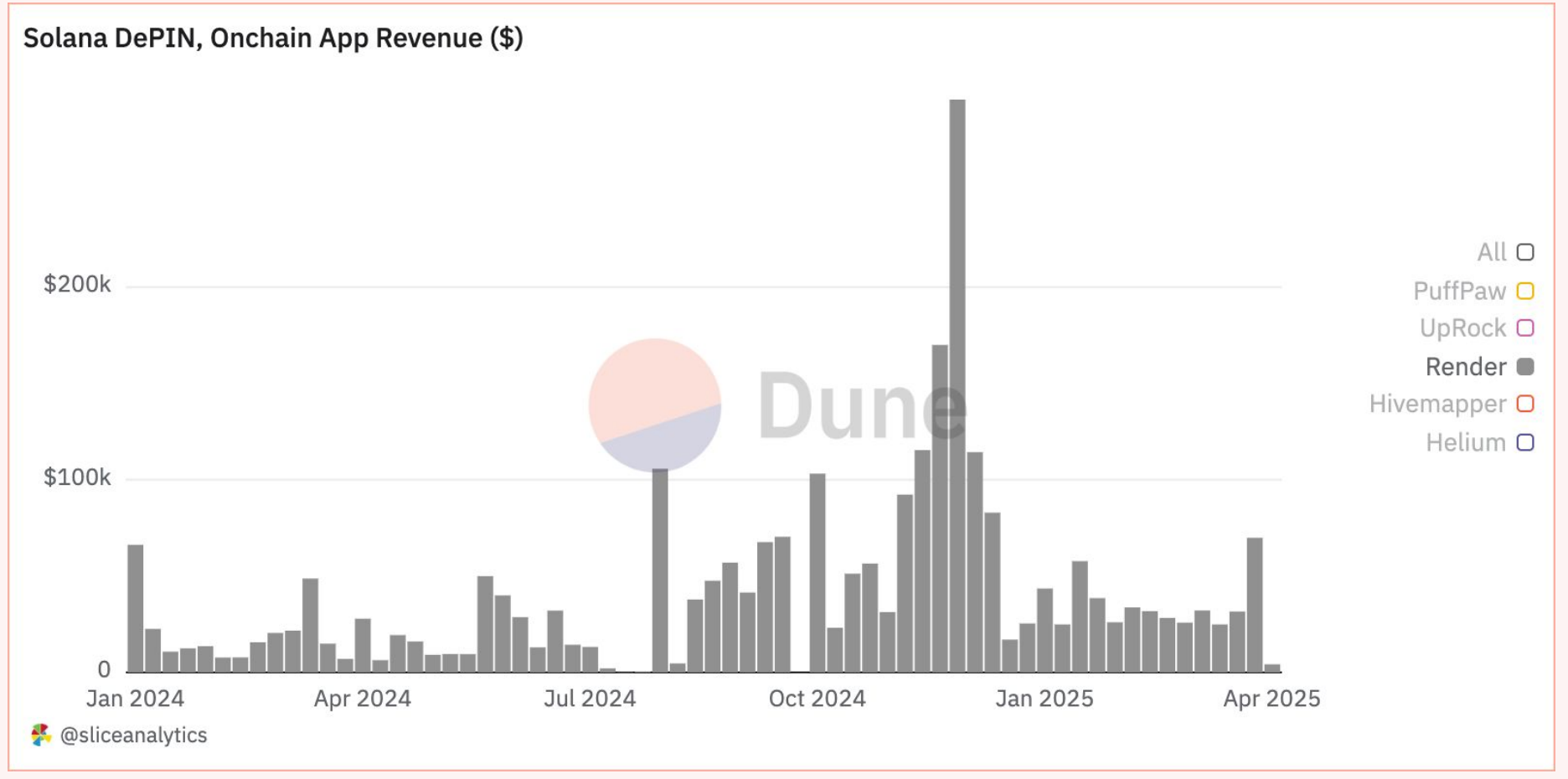
As of April 2025, Render Network has 3,784 active on-chain nodes, providing decentralized computational power for the growing ecosystem of creative and AI applications. To date, user access to GPU capacity has burned over 121 million RENDER tokens, while over 2.4 million tokens have been minted as rewards for node operators, indicating healthy demand and active participation in the ecosystem. Previous reports indicated that revenue peaked at nearly $300,000 per week from November to December 2024, driven by key upgrades (RNP-016 to 018), expanded artist incentives, and the Advent Calendar event featuring free GPU credits and prizes. In mid-April 2025, another significant peak occurred, with weekly revenue reaching $70,000, indicating a resurgence in creator demand and network adoption.
4. Nosana: Decentralized AI Computing Network
Nosana is a decentralized computing network where users can run AI inference tasks through a global GPU host grid. Participants register idle GPUs as nodes and earn $NOS tokens by completing tasks in the network's specific job market. Nosana's solution provides a scalable, censorship-resistant alternative that leverages globally underutilized GPU resources to offer a more cost-effective option for AI computing.
Key Milestones:
- 2024: Launch of the global test grid
- 2024: Release of Node V2, significantly enhancing performance
- 2025: Launch of the GPU market mainnet
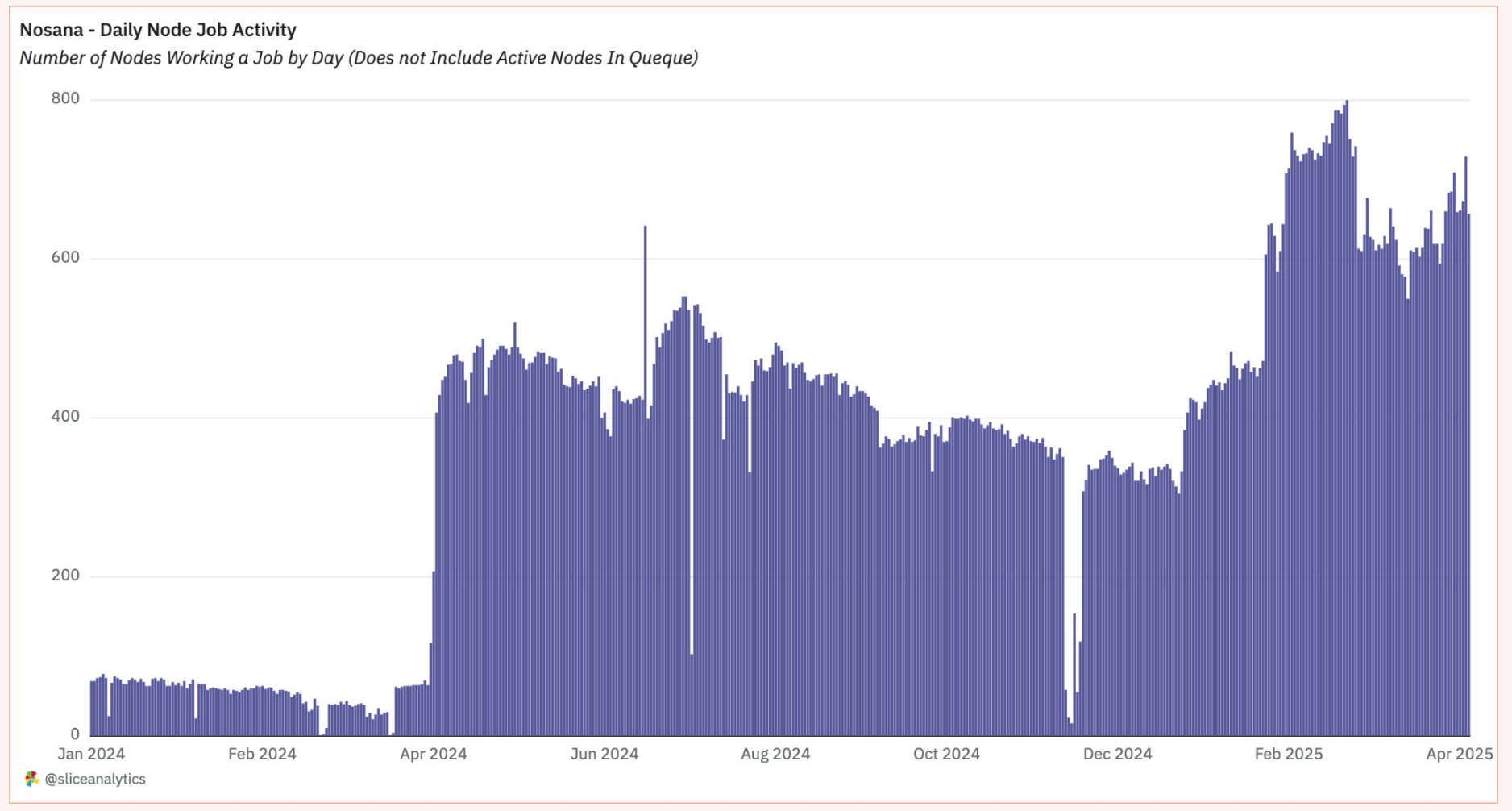
Key Data:
- Global number of nodes: Over 4,200
- Daily active nodes: Increased from an average of 300 in 2024 to over 600 in 2025
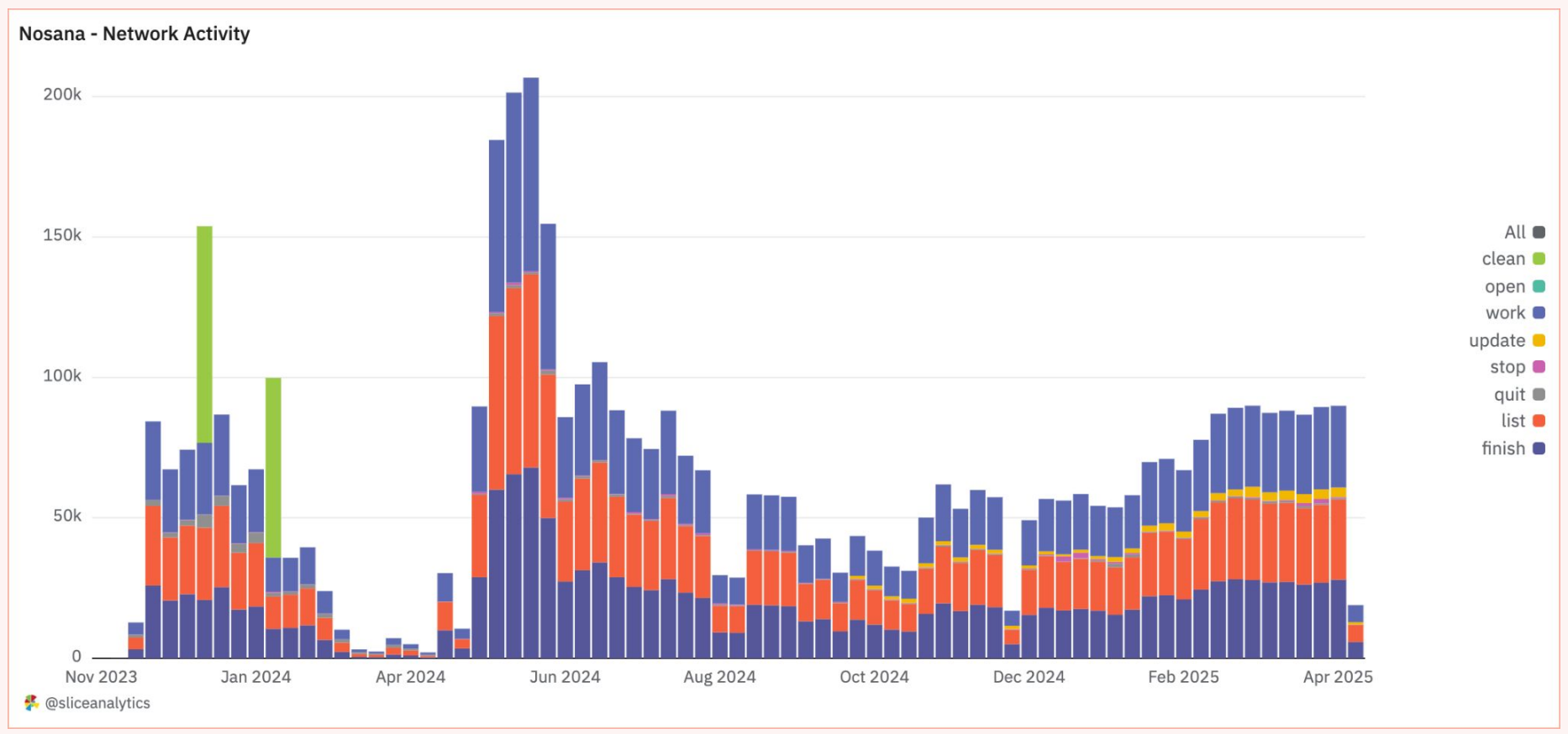
In January 2025, Nosana officially launched its decentralized GPU market to the public. This release, following a year of closed testing, triggered a significant increase in node activity: daily active nodes rose from an average of 300 in 2024 to over 600, peaking above 800 in March 2025. This growth indicates an increasing adoption rate among GPU hosts and AI developers.
With over 4,200 nodes globally, Nosana demonstrates scalable performance and sustained activity, becoming a strong decentralized alternative to traditional computing providers. Its on-chain activity is driven by interactions between node operators and the job market, reflecting the practical use of its decentralized GPU network. The network reached a historical peak of over 200,000 operations per week in May 2024 and stabilized at around 80,000 operations, showing healthy and sustained demand for computational tasks.
Most activities stem from three key command types: creating new job postings, queuing nodes to execute tasks, and completing tasks to receive payment. These three commands represent the core work lifecycle on the network, maintaining a relatively stable usage pattern. Less frequent commands such as stop, exit, and cleanup occur about 1,000 times per week, indicating a low early task termination or cleanup rate, further demonstrating system stability and good alignment of incentive mechanisms.
5. UpRock: Mobile-First Data Intelligence Network
UpRock is a decentralized data intelligence network driven by a mobile-first DePIN model. Users can share unused internet bandwidth and computing power through the UpRock app, transforming everyday devices into passive data contributors to earn $UPT tokens. These resources provide real-time, geographically diverse, and censorship-resistant data support for AI models.
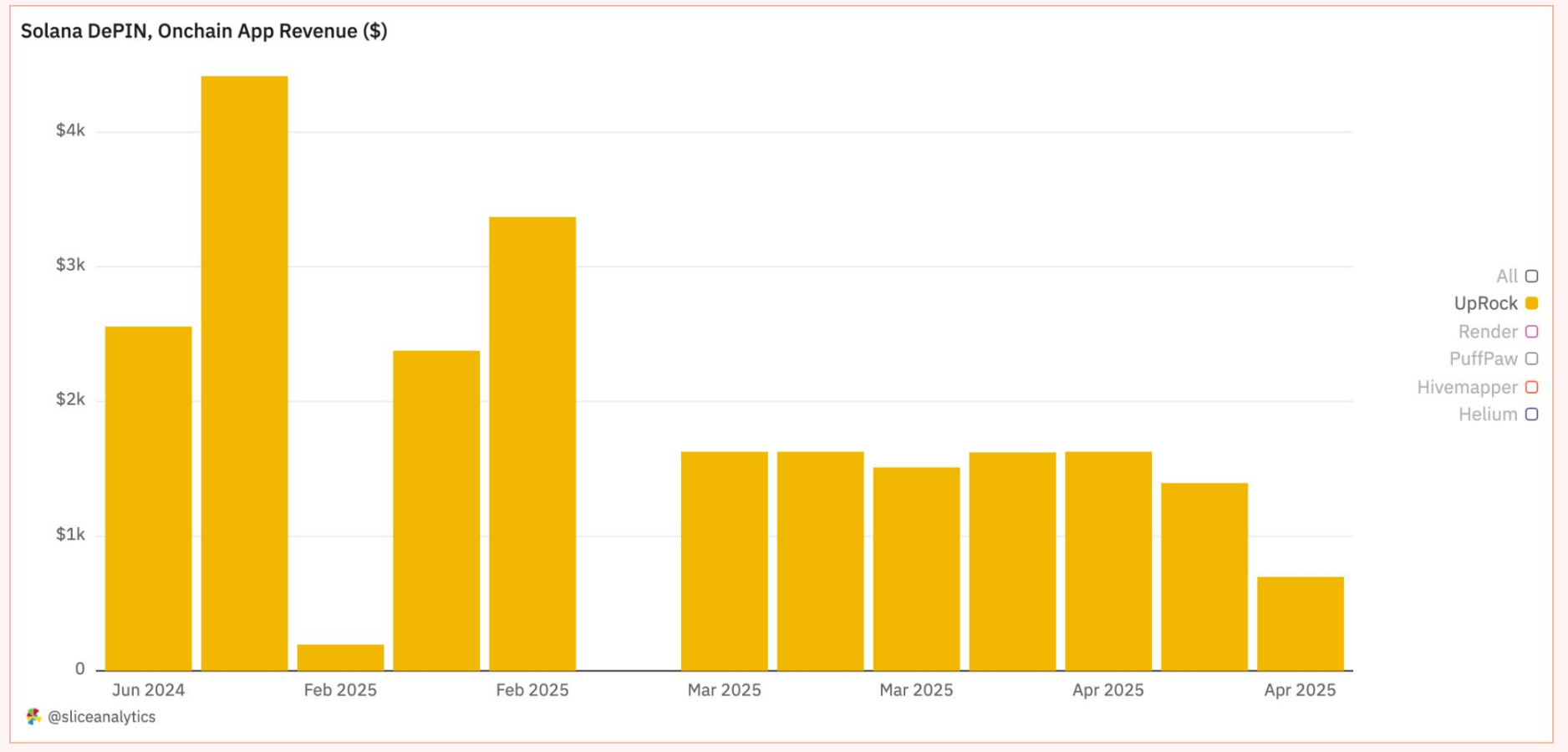
UpRock monetizes through SaaS subscriptions and pay-per-use APIs, with part of the revenue used for on-chain $UPT token buybacks, funding rewards for contributors and strengthening the ecosystem. After reaching a peak of over $3,000 in weekly on-chain network revenue in February 2025, revenue has remained stable at around $1,500 per week.
Conclusion and Key Insights
- Solana's Leadership in the DePIN Space: If the protocol chooses not to launch its own independent L1/blockchain, Solana has become the leading chain for DePIN, with a total market capitalization of $3.25 billion for DePIN projects, averaging $191.3 million per project.
- On-Chain Activity Proves the Real Value of DePIN: DePIN is not just a narrative. Projects like Helium, Render, and Hivemapper have collectively generated nearly $6 million in on-chain network revenue, signaling strong product-market fit.
- Computing and Wireless Categories Dominate the Market: The computing (71.2%) and wireless (22.2%) categories lead the market share in the Solana DePIN space (totaling 93.4%).
- Node Growth and Service Adoption Accelerate: Helium has over 176,000 mobile users and 69,000 nodes, while Hivemapper and Render continue to expand their contributor base. Nosana has doubled its active node count since the mainnet launch.
- Transparency Challenges Remain: Despite practical applications, DePIN remains one of the most challenging areas in crypto to track on-chain activity, as it relies on off-chain hardware and third-party integrations. While progress has been made, achieving complete transparency and consistent on-chain measurement is still ongoing.
免责声明:本文章仅代表作者个人观点,不代表本平台的立场和观点。本文章仅供信息分享,不构成对任何人的任何投资建议。用户与作者之间的任何争议,与本平台无关。如网页中刊载的文章或图片涉及侵权,请提供相关的权利证明和身份证明发送邮件到support@aicoin.com,本平台相关工作人员将会进行核查。



